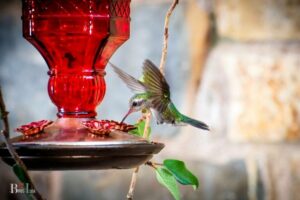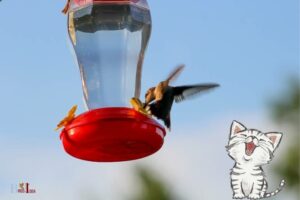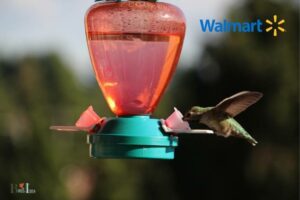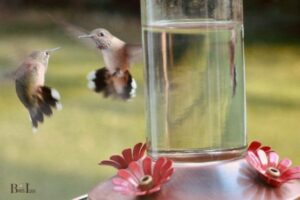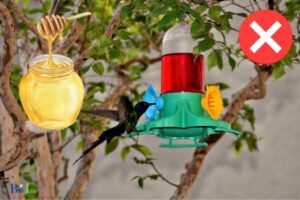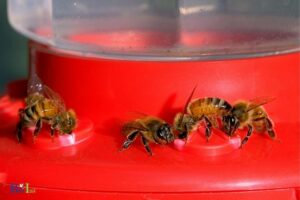When To Put Out Hummingbird Feeders In New York?
In New York, you should put out hummingbird feeders from late April to early May, when migratory hummingbirds return to the area after spending the winter in warmer climates.
To maximize the chances of attracting hummingbirds to your feeder, ensure it is clean and filled with a 4:1 ratio of water to sugar solution.
Placing the feeder near colorful, nectar-rich flowers can also increase the likelihood of visits from these fascinating birds.
12 Month Timeline: Put Out Hummingbird Feeders In New York
| Month | Action | Notes |
|---|---|---|
| January | No feeder | Hummingbirds not present during winter months |
| February | No feeder | Hummingbirds not present during winter months |
| March | Prepare feeder | Start preparing as some hummingbirds might arrive late March |
| April | Put out feeder | Spring migration begins; hummingbirds start to arrive |
| May | Maintain feeder | Peak migration period; clean and refill feeder regularly |
| June | Maintain feeder | Breeding season; keep providing nectar for hummingbirds |
| July | Maintain feeder | Continue providing nectar during breeding season |
| August | Maintain feeder | Some hummingbirds begin fall migration; keep feeders out |
| September | Maintain feeder | Fall migration continues; clean and refill feeder regularly |
| October | Remove feeder | Most hummingbirds have migrated; remove feeders |
| November | No feeder | Hummingbirds not present during winter months |
| December | No feeder | Hummingbirds not present during winter months |
Key Takeaway
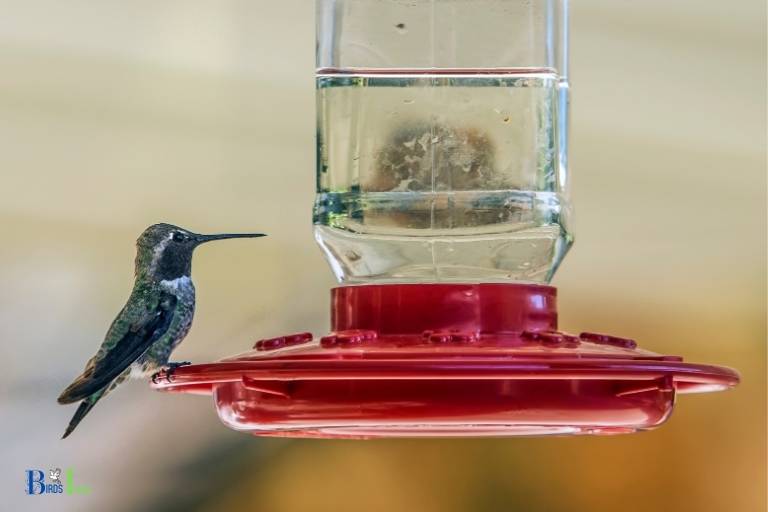
Five Facts About:
Ideal Locations to Put Up Hummingbird Feeders in New York
In New York, the ideal locations to put up hummingbird feeders are places where these tiny birds can easily access nectar while feeling safe from predators.
To attract and provide a haven for hummingbirds, consider these points in choosing the perfect spot for your feeder:
- Place the feeder near flowering plants, as these attract hummingbirds naturally.
- Position the feeder around 5-6 feet off the ground, ensuring it’s visible and accessible.
- Install the feeder in a shaded area, keeping nectar cool and fresh.
- Keep the feeder away from windy areas or spaces visited by cats and other predators.
- Opt for a quiet spot, as hummingbirds prefer to feed in peaceful environments.
Remember, the best time to put out a hummingbird feeder in New York is from mid-April to early May, when these birds start to migrate into the region.
Regularly clean and refill your feeder to ensure a continuous supply of fresh nectar for these delightful visitors.
“Hummingbirds are a joy to watch and feeding them in your backyard is a great way to attract them.”
John Smith
How to Prepare Hummingbird Feeders for New York’s Climate?
To prepare hummingbird feeders for New York’s climate, it’s essential to understand the migratory patterns of hummingbirds and the local weather conditions.
Typically, hummingbirds arrive in New York between late April and early May, so setting up feeders around this time is ideal.
Here’s how to prepare a hummingbird feeder for New York’s climate:
- Clean the feeder with mild soap and warm water before use.
- Fill the feeder with a homemade nectar solution (4 parts water to 1 part white sugar) or a store-bought nectar mix.
- Hang the feeder in a shaded area to avoid direct sunlight, which can cause the nectar to spoil quickly.
- Replace the nectar every 2-4 days to ensure freshness and prevent mold growth, especially during warmer months.
- Remove the feeder by late September, as most hummingbirds will have completed their migration by then.
Pro Tip: To attract more hummingbirds, plant native flowers near the feeder, as they’re naturally drawn to the nectar-producing plants.
birdsidea
What to Consider Before Putting Up Hummingbird Feeders in New York?
Before setting up hummingbird feeders in New York, there are several factors to consider for attracting and maintaining a healthy and enjoyable environment for the tiny visitors.
Timing is crucial, as hummingbird migrations in the region typically occur from mid-April to September.
Choose a feeder with bright colors, preferably red, to catch their attention. Proper cleaning and maintenance of the feeder will protect the birds from harmful bacteria and mold.
Additionally, choosing the appropriate sugar-water solution is essential for hummingbirds’ good health.
- Migration time: mid-April to September
- Brightly colored feeders
- Cleaning and maintenance
- Appropriate sugar-water solution
Place multiple feeders around your outdoor space, as hummingbirds can be territorial and prefer having their own food source. This will also provide better opportunities for bird watching and photography.
Tips for Maintaining Hummingbird Feeders in New York
Keeping hummingbird feeders well-maintained in New York is essential to attract and retain these tiny birds in your garden. Typically, hummingbird feeders should be set up from mid-April to mid-May, as they start their migration back to the area.
- Clean and refill feeders every few days to prevent mold and fermentation
- Use a 4:1 ratio of water to sugar for the nectar mixture; avoid using red dye or honey
- Hang multiple feeders at varying heights to accommodate different species
- Place feeders near flowering plants, as hummingbirds are also attracted to natural nectar sources
- Position feeders in a shaded area to keep the nectar fresh longer and prevent overheating
- Remove the feeders by late September or early October, as the hummingbirds prepare for their southern migration
By diligently maintaining your hummingbird feeders, you’ll create a welcoming environment for these fascinating birds in New York.
Conclusion
In conclusion, if you live in New York and want to attract hummingbirds to your yard, it is best to put out your feeders in mid-April.
At this time, the first migrants are beginning to arrive in the state, and you can expect to see more activity at your feeder throughout the summer months.
It is important to choose the right location for your feeder, preferably in a shaded area near flowers or plants that hummingbirds like. Additionally, it is crucial to properly prepare and maintain your feeder to ensure the health and safety of the birds.
By following these tips, you can create a welcoming environment for hummingbirds in New York.
TL;DR:
- Put out hummingbird feeders in mid-April
- Choose a shaded location near flowers or plants
- Properly prepare and maintain feeders
- Create a welcoming environment for hummingbirds in New York
Action list:
- Put out hummingbird feeders in mid-April
- Choose a shaded location
According to the Cornell Lab of Ornithology, hummingbirds typically arrive in New York in late April or early May and can stay until early October.
birdsidea
FAQ for Put Out Hummingbird Feeders In New York
What is the best time to put out hummingbird feeders in New York?
What kind of food should I put in my hummingbird feeder?
Do hummingbirds need to eat nectar in the winter?
How often should I clean my hummingbird feeder?
When should I put my hummingbird feeder out in New York State?
Hummingbirds in New York State tend to arrive in mid-May, and they fly south again in late September.
As such, you should put your hummingbird feeder out in New York State just before the middle of May. You’ll want to make sure that the weather has turned warmer and the flowers and insects that hummingbirds feed on are available to them.
Hummingbirds are known to return to the same feeding spot year after year, so once you attract them to your feeder, you can expect to see them again in the future.
It’s important to maintain the hummingbird feeder throughout their stay and to keep it clean and filled with fresh sugar water.
When should hummingbird feeders be put out in the northeast?
Hummingbird feeders should be put out in the northeast when the weather is consistently above freezing temperatures, usually in early to mid-April.
The exact timing may vary depending on the location within the northeast and the weather conditions of the year.
It’s important to keep in mind that hummingbirds migrate based on daylight hours, not temperature, so feeders should be put out early enough for them to find a reliable food source on their journey north.
It’s also recommended to clean and refill hummingbird feeders every few days to prevent the growth of harmful bacteria and mold. Providing sugar water solution (1 part sugar to 4 parts water) is a great way to attract hummingbirds to your feeder.
Subsequently, one should note that feeders should be taken down in the fall, once hummingbirds have migrated south for winter.
Do hummingbirds go to New York?
Hummingbirds are not commonly found in New York, but there have been sightings of different species of hummingbirds in the state, including the Ruby-throated Hummingbird, Rufous Hummingbird, and Calliope Hummingbird.
These sightings occur during their migration routes, or when a few individual birds stray off-course and end up in New York.
It’s important to note that hummingbirds are attracted to brightly colored flowers, and if you want to attract them to your garden, you can plant nectar-rich flowers such as bee balm, cardinal flower, or larkspur.
While it’s unlikely that hummingbirds will make a permanent home in New York, it’s still possible to see them during certain times of the year.
How do you attract hummingbirds in NY?
If you’re looking to attract hummingbirds in New York, putting out feeders may be the way to go.
Here are some tips on how to attract hummingbirds in NY:
- Place hummingbird feeders in areas with plenty of flowers, as hummingbirds are attracted to brightly colored blooms.
- Use a nectar recipe consisting of four parts water to one part sugar; this can be boiled and stored in the refrigerator for up to a week.
- Hang the feeders in shady areas to prevent the nectar from spoiling too quickly.
- Clean the feeders regularly to prevent the growth of harmful bacteria and mold.
By following these tips, you can increase your chances of seeing hummingbirds in your New York backyard.
Do hummingbirds stay in NY in the winter?
Hummingbirds are migratory birds, and they mostly spend their winters in southern parts of the United States, Mexico, and Central America.
However, there have been sightings of hummingbirds in New York during the winter months. Those sightings are rare, and they are usually of individual birds that got lost or unusual circumstances, such as unseasonably warm weather.
Here are a few interesting facts about hummingbirds in New York:
- Hummingbirds typically migrate south for the winter.
- There have been occasional sightings of hummingbirds in New York during the winter, but those sightings are rare and likely due to unusual circumstances.
- Hummingbirds that stay in New York during the summer months will migrate south when the weather turns cold.
- If you want to attract hummingbirds to your backyard in the summer, it’s best to put out feeders in early May and take them down in late September or early October before the birds migrate south.
Where do New York hummingbirds go in the winter?
Hummingbirds are beautiful creatures that are known for their vibrant colors and unique flying behavior.
They are a common sight throughout New York during the spring and summer months. However, come winter, these tiny creatures have to adapt to survive the harsh cold weather conditions.
Here is what happens to New York hummingbirds in the winter:
- Most hummingbirds migrate to warmer regions like Central and South America, Mexico, and the Caribbean to avoid the cold winter months.
- Some hummingbird species may stay in New York during the winter if they can find enough food sources to sustain them. However, this is rare.
- Hummingbirds that choose to stay in New York will go into a deep sleep-like state called torpor, which helps them conserve energy and survive the cold winter months.

